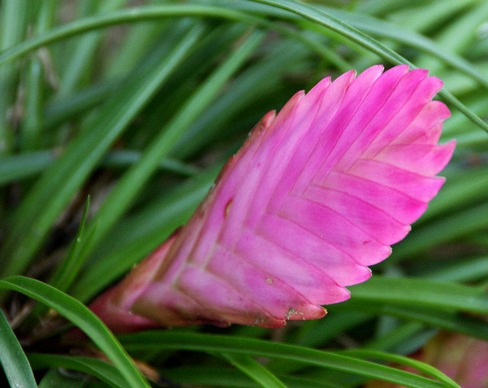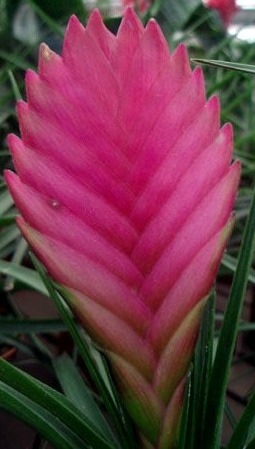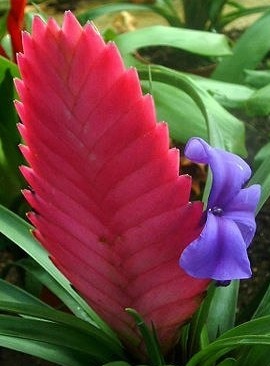Tillandsia Plants
Pink Quill Bromeliads
Most Air Plants do not have roots. Some species do have roots; however, the roots are primarily used to anchor the plants in place.
Since the roots do not absorb water, these plants gather moisture and nutrients through their leaves.
One species, T. cyanea (Pink Quill), can be grown in a pot. The Pink Quill bromeliad gets its name from the densely packed, overlapping, bright pink bracts that form a plume.
Other tillandsia species are pinned, tied, or glued onto a mount, such as a piece of twisted wood or a large seashell.
This bromeliad species blooms and then produces offsets. Most
 tillandsias reach maturity in
three to five
years.
tillandsias reach maturity in
three to five
years.All Air Plant bromeliads are small plants with thin, dark green or greenish-gray leaves.
They rarely grow more than 6 in/15 cm high and wide. If you are growing these plants outdoors, consider displaying them attached to tree ferns and other trees, or growing them in a rock garden.
Tillandsia Plants (Air Plants) - Basic Information and Bromeliad Care Tips
Lighting Requirements
This bromeliad prefers bright light. Air plants will tolerate some direct sun in the winter, but not in the summer.
Temperature Requirements
In the spring, summer, and early fall, warm temperatures (80° F / 27° C) are ideal. In the winter cool temperature in the 60° F / 16° C range are best.
Fertilizer
In the spring and summer months, feed air plants every two weeks by spraying them with a high phosphorus fertilizer, diluted to ½ the normal strength. Leaf scales absorb the nutrients in the fertilizer. No fertilizer is required in the fall and winter months.
Water
Spray plants with water twice a week – make sure they are thoroughly wet. The plant should dry out in approximately four hours. Avoid soaking the base of the plant.
Soil
No soil is needed for most varieties. Sphagnum moss can be used for air plants to rest on. Pink Quill can be grown in orchid potting medium.
Propogation
Propagate offsets when they are one-third the size of the parent plant. Drill small holes in a piece of untreated wood to create a temporary resting place for these pups.
Repotting

To accommodate new growth, reposition tillandsia plants as needed (approximately every two to three years.
Longetivity
Individual plants live five years or more.
Selection
Air plants are sold by their common names, or labeled as T. ionantha or T. usneoides (Spanish Moss).
Uses and Display Tips
Pink Quill (T. cyanea), can be grown in a pot. Others tillandsia species can be pinned, tied, or glued onto a mount, such as twisted piece of wood or a large seashell.





